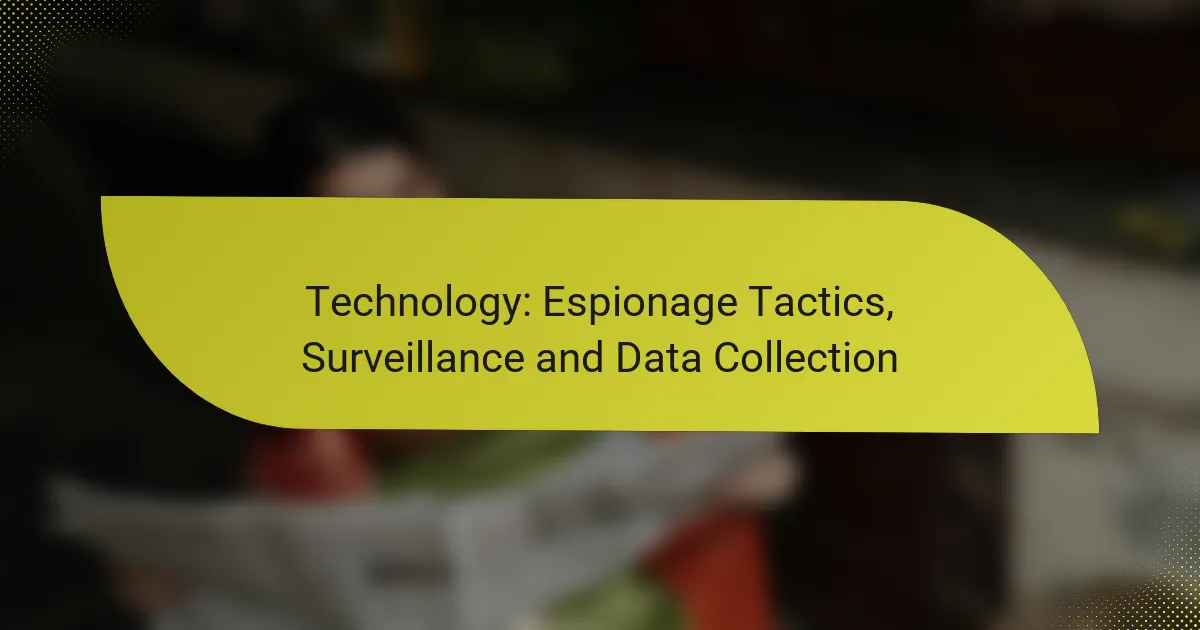In the realm of technology, espionage tactics leverage system vulnerabilities and human behavior to extract sensitive information, often employing deception that makes detection difficult. Surveillance technologies, such as CCTV, drones, and facial recognition, are increasingly prevalent in urban areas, raising significant privacy concerns. Additionally, diverse data collection methods, including web scraping and social media monitoring, allow organizations to gain valuable insights, serving various purposes from market research to security enhancement.

What are the most effective espionage tactics used in technology?
Effective espionage tactics in technology include methods that exploit vulnerabilities in systems and human behavior to gather sensitive information. These tactics often rely on deception and manipulation, making them challenging to detect and prevent.
Phishing attacks
Phishing attacks involve tricking individuals into revealing personal information, such as usernames and passwords, often through deceptive emails or websites. Attackers typically impersonate trusted entities to lure victims into clicking malicious links or downloading harmful attachments.
To protect against phishing, users should verify the sender’s email address, avoid clicking on suspicious links, and use multi-factor authentication whenever possible. Regular training on recognizing phishing attempts can significantly reduce the risk of falling victim.
Man-in-the-middle attacks
Man-in-the-middle (MitM) attacks occur when an attacker intercepts communication between two parties without their knowledge. This tactic allows the attacker to eavesdrop, alter messages, or impersonate one of the communicating parties.
To mitigate MitM risks, users should utilize secure connections, such as HTTPS, and employ virtual private networks (VPNs) when accessing public Wi-Fi. Regularly updating software and using encryption can further enhance security against these attacks.
Social engineering techniques
Social engineering techniques manipulate individuals into divulging confidential information by exploiting psychological factors. This can include tactics like pretexting, where an attacker creates a fabricated scenario to gain trust and extract sensitive data.
Awareness is key in combating social engineering. Organizations should implement strict verification processes for sensitive information requests and educate employees about common tactics used by attackers. Regular security drills can help reinforce these practices.
Malware deployment
Malware deployment involves installing malicious software on a target’s device to steal data, disrupt operations, or gain unauthorized access. This can occur through infected downloads, email attachments, or compromised websites.
To defend against malware, users should maintain updated antivirus software, avoid downloading from untrusted sources, and regularly back up important data. Implementing application whitelisting can also prevent unauthorized programs from executing.
Network infiltration
Network infiltration refers to unauthorized access to a computer network, allowing attackers to gather information or disrupt services. This can be achieved through various means, including exploiting software vulnerabilities or using stolen credentials.
To protect networks, organizations should implement robust firewalls, conduct regular security audits, and monitor for unusual activity. Employing network segmentation can limit the potential damage from an infiltration, ensuring that sensitive data remains secure.
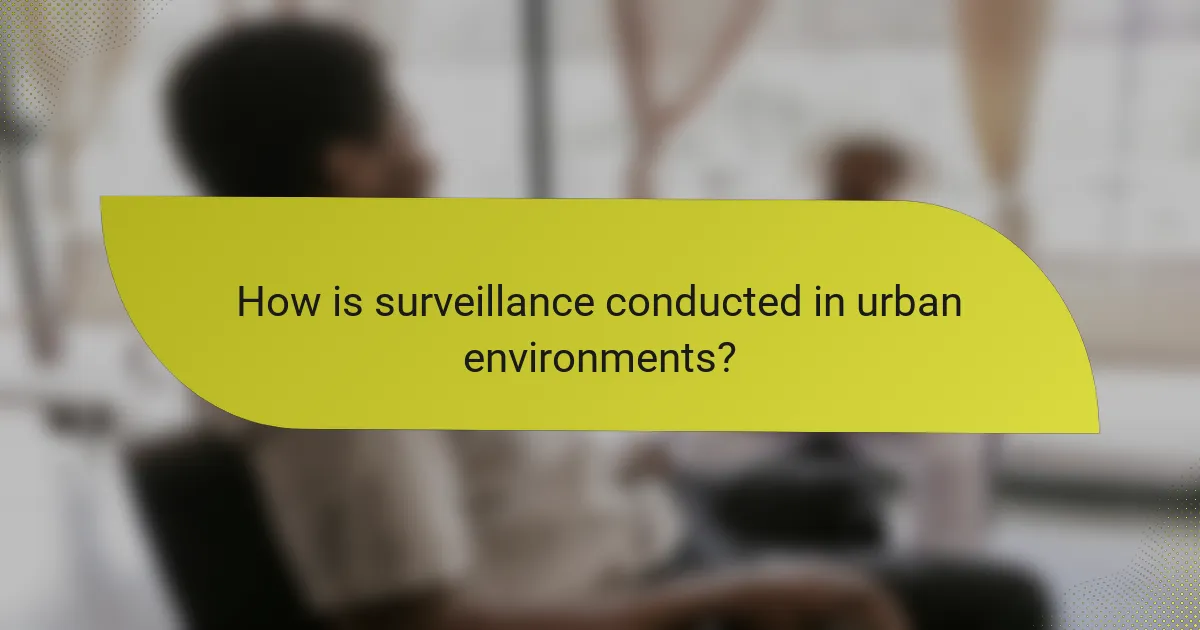
How is surveillance conducted in urban environments?
Surveillance in urban environments is primarily conducted through various technologies that monitor public spaces and track individuals. These methods include the use of CCTV cameras, drones, mobile device tracking, and facial recognition technology, each serving distinct purposes and raising unique privacy concerns.
Use of CCTV cameras
CCTV cameras are widely deployed in urban areas to monitor public spaces, deter crime, and assist law enforcement. They are often installed in high-traffic locations such as streets, parks, and transportation hubs.
While effective for real-time monitoring, the use of CCTV raises privacy issues, as footage can be stored and analyzed later. Cities may have regulations regarding how long footage is kept and who can access it, which varies by region.
Drone surveillance
Drones are increasingly utilized for surveillance in urban settings, providing aerial views that can cover large areas quickly. They are often used for crowd monitoring during events or for assessing emergency situations.
However, drone surveillance can be controversial due to concerns about privacy and noise pollution. Regulations typically require operators to maintain a certain distance from people and to avoid restricted airspace.
Mobile device tracking
Mobile device tracking involves monitoring the location and movements of individuals through their smartphones. This can be done through GPS data, Wi-Fi signals, or cellular network triangulation.
While useful for urban planning and traffic management, this method raises significant privacy concerns. Users often have limited awareness of how their data is collected and used, leading to calls for stricter regulations on consent and data protection.
Facial recognition technology
Facial recognition technology is employed in urban surveillance to identify individuals in real-time using cameras. This technology can enhance security measures but also poses risks to personal privacy.
Many cities are debating the ethical implications of using facial recognition, with some jurisdictions implementing bans or strict regulations. The accuracy of the technology can vary, leading to potential misidentifications, especially among diverse populations.
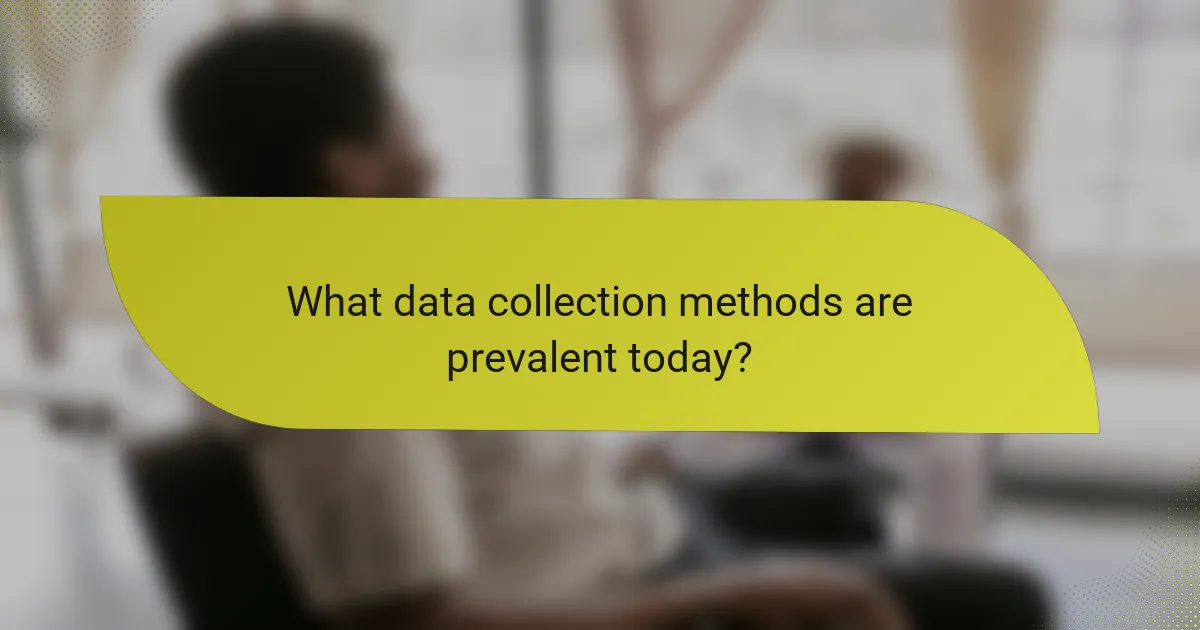
What data collection methods are prevalent today?
Today, various data collection methods are widely used, including web scraping, social media monitoring, IoT data harvesting, and public records analysis. These techniques enable organizations to gather valuable insights from diverse sources, often for purposes such as market research, security, and surveillance.
Web scraping
Web scraping involves automated tools that extract data from websites. This method is commonly used to gather information such as product prices, customer reviews, and competitor analysis. While web scraping can be effective, it is essential to comply with website terms of service and local regulations to avoid legal issues.
Many businesses use web scraping to monitor trends and gather data efficiently. Tools like Beautiful Soup and Scrapy are popular for their ease of use and flexibility in handling various data formats.
Social media monitoring
Social media monitoring tracks user interactions and content across platforms like Facebook, Twitter, and Instagram. This method helps organizations understand public sentiment, track brand reputation, and identify emerging trends. It is crucial to respect user privacy and adhere to platform guidelines when collecting this data.
Tools such as Hootsuite and Brandwatch allow businesses to analyze social media conversations and gather insights on customer preferences. Regularly reviewing this data can inform marketing strategies and product development.
IoT data harvesting
IoT data harvesting refers to collecting information from interconnected devices, such as smart home appliances and wearables. This method provides real-time insights into user behavior and device performance. However, it raises concerns about data privacy and security, making compliance with regulations like GDPR essential.
Organizations can leverage IoT data to enhance customer experiences and optimize operations. For example, smart thermostats collect usage data to improve energy efficiency and user comfort.
Public records analysis
Public records analysis involves examining data that is legally available to the public, such as court records, property deeds, and government reports. This method can uncover valuable information for various purposes, including background checks and market research. However, the accessibility of public records can vary by jurisdiction.
Utilizing public records can provide insights into demographic trends and property values. Tools like LexisNexis and local government databases can facilitate this analysis, but users should remain aware of the ethical considerations surrounding data use.
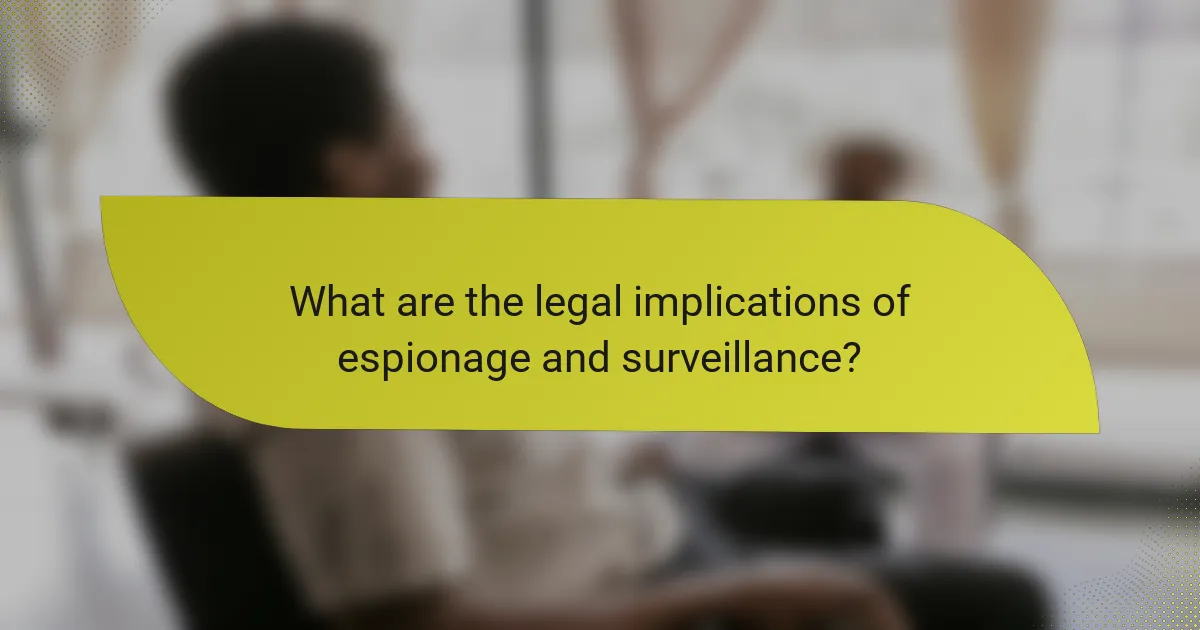
What are the legal implications of espionage and surveillance?
The legal implications of espionage and surveillance vary significantly across jurisdictions, often balancing national security interests with individual privacy rights. Violations can lead to severe penalties, including fines and imprisonment, depending on the laws in place.
Privacy laws in the US
In the United States, privacy laws are primarily governed by a mix of federal and state regulations. Key legislation includes the Electronic Communications Privacy Act (ECPA) and the Foreign Intelligence Surveillance Act (FISA), which set boundaries on government surveillance and data collection practices.
Individuals should be aware that while the Fourth Amendment protects against unreasonable searches, exceptions exist for national security and law enforcement. Companies collecting personal data must also comply with various state laws, such as the California Consumer Privacy Act (CCPA), which grants consumers rights over their personal information.
GDPR regulations in Europe
The General Data Protection Regulation (GDPR) is a comprehensive data protection law in the European Union that regulates how personal data is collected, processed, and stored. It emphasizes the need for explicit consent from individuals before their data can be used, making it a robust framework for privacy protection.
Under GDPR, organizations face significant fines for non-compliance, which can reach up to 4% of their global annual revenue. Individuals have rights such as access to their data, the right to be forgotten, and the right to data portability, which empower them to control their personal information effectively.
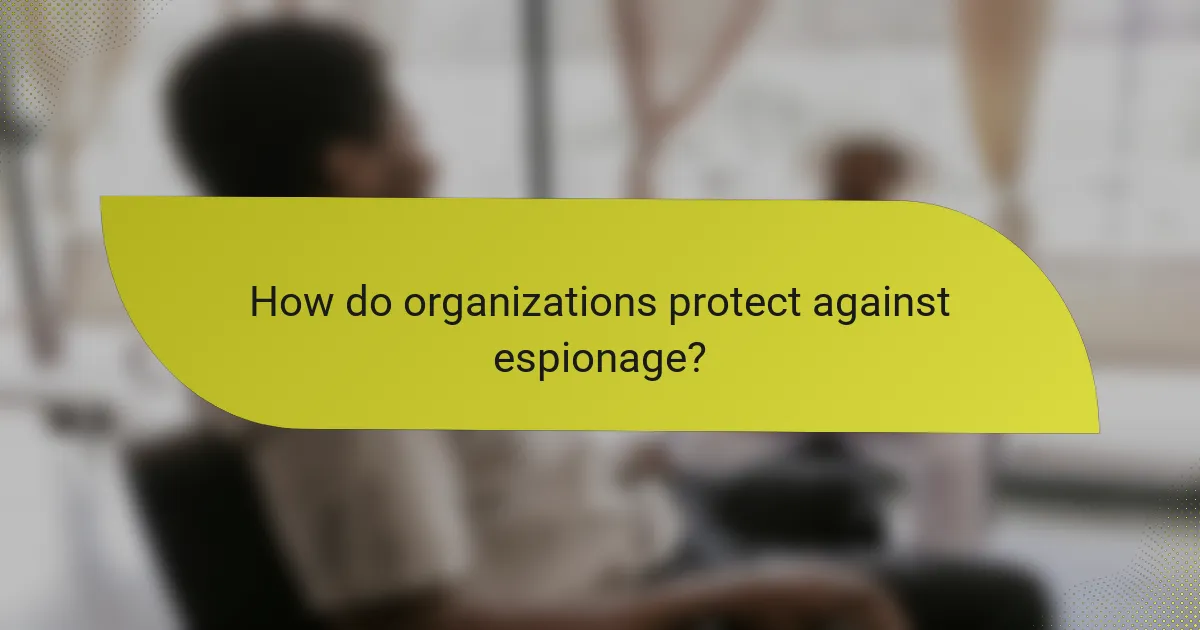
How do organizations protect against espionage?
Organizations protect against espionage by implementing a combination of technological solutions, employee training, and strict policies. These measures aim to safeguard sensitive information and prevent unauthorized access or data breaches.
Implementing cybersecurity measures
Cybersecurity is a critical component in protecting against espionage. Organizations should deploy firewalls, intrusion detection systems, and encryption protocols to secure their networks and data. Regular software updates and vulnerability assessments help identify and mitigate potential threats.
Additionally, using multi-factor authentication can significantly reduce the risk of unauthorized access. Organizations should also consider employing security information and event management (SIEM) systems to monitor and analyze security events in real-time.
Employee training and awareness
Training employees on security best practices is essential for preventing espionage. Regular workshops and seminars can educate staff about recognizing phishing attempts, social engineering tactics, and the importance of safeguarding sensitive information. Employees should be encouraged to report suspicious activities immediately.
Creating a culture of security awareness can empower employees to take an active role in protecting the organization. Simple measures, such as using strong passwords and avoiding unsecured networks, can significantly enhance overall security.
Establishing strict policies and protocols
Organizations should develop clear policies regarding data access, sharing, and handling. These policies should outline who has access to sensitive information and under what circumstances. Regular audits can ensure compliance with these policies and identify any potential gaps.
Additionally, organizations may implement non-disclosure agreements (NDAs) for employees and third parties to legally protect sensitive information. Establishing a clear incident response plan is also crucial for addressing potential espionage threats effectively.
